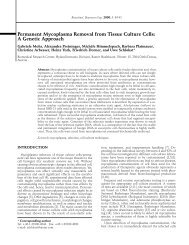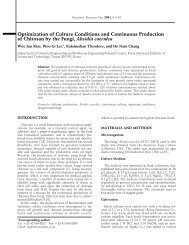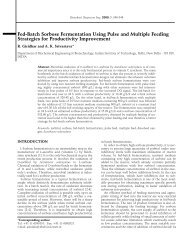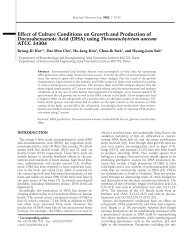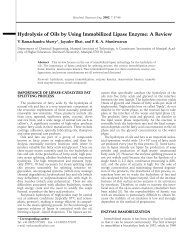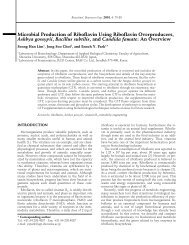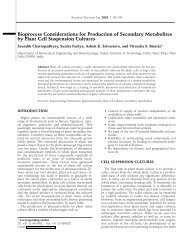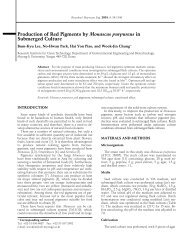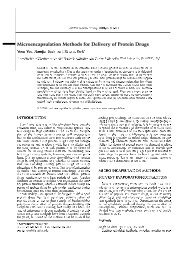Growth Promotion of Taxus brevifolia Cell Suspension Culture Using ...
Growth Promotion of Taxus brevifolia Cell Suspension Culture Using ...
Growth Promotion of Taxus brevifolia Cell Suspension Culture Using ...
You also want an ePaper? Increase the reach of your titles
YUMPU automatically turns print PDFs into web optimized ePapers that Google loves.
Biotechnol. Bioprocess Eng. 2000, 5: 350-354<strong>Growth</strong> <strong>Promotion</strong> <strong>of</strong> <strong>Taxus</strong> <strong>brevifolia</strong> <strong>Cell</strong> <strong>Suspension</strong> <strong>Culture</strong><strong>Using</strong> Conditioned MediumMyung-Hwan Kim, Su Hwan Chun, and Dong-Il Kim*Department <strong>of</strong> Biological Engineering and Institute <strong>of</strong> Industrial Biotechnology, Inha University, Inchon 402-751, KoreaAbstract The growth promotion <strong>of</strong> a <strong>Taxus</strong> <strong>brevifolia</strong> cell suspension culture was investigatedusing conditioning factors. The conditioning factors produced and secreted from culturedcells usually stimulate cell division and the production <strong>of</strong> secondary metabolites.Therefore, the effective incubation time for the optimal secretion <strong>of</strong> conditioning factors wasfirstly determined for the promotion <strong>of</strong> cell growth. Conditioned media obtained by cultivatingfor 2 and 5 days showed the promotion <strong>of</strong> initial cell growth during the early cell growthperiod. However, the positive effect <strong>of</strong> the conditioning factors on the initial cell growth didnot continue because <strong>of</strong> the depletion <strong>of</strong> the medium nutrients. Accordingly, the addition <strong>of</strong>a carbon source to the conditioned medium prolonged the positive effect on the cell growth.The addition <strong>of</strong> sucrose to the conditioned medium resulted in the maximum cell density beingreached 4 days earlier compared to the control group and an increased substrate yield.Keywords: conditioning factor, conditioned medium, <strong>Taxus</strong> <strong>brevifolia</strong>INTRODUCTIONAs the sources <strong>of</strong> various biochemical substances,higher plants have been used to produce pharmaceuticals,flavors, fragrances, and insecticides. Traditionally,these substances have been obtained using direct extractionfrom the intact plant on a large scale; however,certain <strong>of</strong> these substances are actually produced throughchemical syntheses. Plant cells grow faster than theplants itself, are not limited to geographic or weatherconditions, and can promote the production <strong>of</strong> secondarymetabolites by metabolic regulation under optimalconditions through artificially controlling the environment[1]. However, the comercialization <strong>of</strong> plant cellcultures is not yet possible due to the difficulty <strong>of</strong> largescalecultivation, low yields, the instability <strong>of</strong> cell lines,relatively slow growth characteristics compared to microbialcells, and difficulties in purification and separation[2].Although secondary metabolites do not affect theimportant basic metabolism <strong>of</strong> cells, they help in thephysiological activation <strong>of</strong> cells and carry out the function<strong>of</strong> a defense mechanism against various pathogens.The biosynthetic pathway <strong>of</strong> these secondary metabolites<strong>of</strong> plants is very complicated, implying a complexrelationship among various enzymes related to the production<strong>of</strong> the metabolites [3]. Plant cell biotechnologyis currently being considered as a method <strong>of</strong> producingsecondary metabolites and related research on increasedproductivity at a reduced cost needs to be continued [4].*Corresponding authorTel: +82-32-860-7515 Fax: +82-32-875-0827e-mail: kimdi@inha.ac.krIn addition, to increase the productivity <strong>of</strong> secondarymetabolites, researches are progressing in bioreactordesign, optimization <strong>of</strong> culture conditions, elicitation,signal transduction, and redirecting the biosyntheticpathway in order to scale up and commercialize theplant cell culture process [5].At the time <strong>of</strong> inoculation, a plant cell culture needsto maintain a minimum inoculation concentration. Ifthe inoculation level is under the minimum concentration,the initial cell division becomes difficult since theconditioning factors that are either secreted from thecells or present in the culture do not accommodate theconditions required for growth. Normally, it is the cellthat produce the conditioning factors that change thesurrounding environment to accommodate cell growth.However, if a conditioned medium containing theseconditioning factors is provided, inoculation under theminimum concentration would be possible and cellgrowth could be promoted [6,7]. Yet, these conditioningfactors have not been clearly identified, and only afew potential substances have been reported. When theinitial cell concentration is relatively low and the phosphateconcentration in the medium is high, cell growthhas been observed to be reduced, indicating that an excessamount <strong>of</strong> phosphate acts as a negative conditioningfactor for cell growth [8]. In contrast, Sun et al. [9]reported that extracellular calmodulin promotes plantcell growth through a physiological interaction with anunknown extracellular component or various factors inthe cell wall. Conditioning factors not only promotecell growth but also increase productivity <strong>of</strong> the secondarymetabolites. When anthocyanin is produced by astrawberry suspension culture, the productivity hasbeen reported to increase with a conditioned medium
Biotechnol. Bioprocess Eng. 2000, Vol. 5, No. 5 351and the ratio <strong>of</strong> the anthocyanin components changes[6,10]. The growth-stimulating effects <strong>of</strong> these conditioningfactors and increased productivity <strong>of</strong> secondarymetabolites has been reported to be possible in varioustypes <strong>of</strong> plant cells [7]. Another study related with thissubject reported that anthocyanin production from arose suspension culture was enhanced when using aconditioned medium obtained from a strawberry suspensionculture [11].Accordingly, the present study attempted to improveproductivity by promoting the growth <strong>of</strong> a <strong>Taxus</strong> <strong>brevifolia</strong>cell culture, which produces the plant-originatedanti-tumor agent paclitaxel. Therefore, a conditionedmedium was introduced to obtain growth conditionswithout a lag phase during the initial growth periodand prolong the growth-stimulating effect for the promotion<strong>of</strong> cell growth.MATERIALS AND METHODS<strong>Suspension</strong> <strong>Cell</strong> <strong>Culture</strong> and MediaThe <strong>Taxus</strong> <strong>brevifolia</strong> (Pacific yew) suspension cell cultureused in the present study was induced from anexplant <strong>of</strong> a Pacific yew tree provided by Dr. HenrikPedersen (Rutgers University, USA) and the cells weregrown in Schenk and Hiderbrandt (SH) medium [12]with the addition <strong>of</strong> 20 g/L <strong>of</strong> sucrose as the carbonsource. Five mg/L <strong>of</strong> α-naphtaleneacetic acid (NAA) and0.2 mg/L <strong>of</strong> 6-benzylaminopurine (BAP) were added asgrowth regulators along with a vitamin concentratedsolution supplement. The pH was set at 5.8 with theaddition <strong>of</strong> 1 N NaOH before autoclaving and a subculturewas done every 12 days. The cell culture was performedin a rotary shaker under dark conditions at 120rpm while maintaining a temperature <strong>of</strong> 25 o C.Preparation <strong>of</strong> Conditioned MediumThe conditioned medium was prepared from the T.<strong>brevifolia</strong> suspension cell culture. Eighty mL <strong>of</strong> the culturebroth including cells was inoculated into 170 mL <strong>of</strong>the new culture medium and subculture was takenevery 12 days. Based on the time lapse after each subculture,different conditioned media were made byseparating the cells and the culture in a vacuum using aWhatman No. 1 filter in a Buchner funnel under sterileconditions.Analytical MethodsAfter the removal <strong>of</strong> the culture medium in a vacuumusing a Whatman No. 1 filter paper, the cells werewashed with the same amount <strong>of</strong> distilled water twiceto eliminate any remaining sugar on the cell surface andthen dehydrated under vacuum. The filtered cells weretransferred to an aluminum weighing-tray and the freshcell weight (FCW) was measured using a chemical balance.After measuring the FCW, the cells were dehy- Fig. 1. Effect <strong>of</strong> conditioned medium on initial cell growth insuspension culture <strong>of</strong> T. <strong>brevifolia</strong>.drated in a drying oven at 60 o C until a constant weightwas achieved then the dry cell weight (DCW) wasmeasured.To determine the amount <strong>of</strong> sugar used relative tothe cell growth, the concentrations <strong>of</strong> sucrose, glucose,and fructose were analyzed using an HPLC system consisting<strong>of</strong> a pump (Model 910, Young-In Scientific Co.,Korea), refractive index (RI) detector (Waters Co., USA),and a carbohydrate column (4.6 × 250 mm) as a stationaryphase. As for a mobile phase, a mixture <strong>of</strong> acetonitrileand water at the ratio <strong>of</strong> 80:20 was used underisocratic conditions with a flow rate <strong>of</strong> 1.0 mL/min.RESULTS AND DISCUSSIONEffect <strong>of</strong> Conditioned Medium in <strong>Taxus</strong> <strong>brevifolia</strong><strong>Suspension</strong> <strong>Culture</strong>To observe the initial cell growth <strong>of</strong> T. <strong>brevifolia</strong> dueto a conditioned medium, experiments were conductedusing the conditioned medium obtained 5 days aftersubculture. As shown in Fig. 1, when the conditionedmedium obtained on the 5th day after subculture wasused, the results showed no lag phase, which is normallyexperienced during the initial cell growth period,plus the initial cell growth increased compared to that<strong>of</strong> the control group. The maximum cell concentrationwas seen on the 6th day after applying the conditionedmedium, after which there was no more cell growthand the stationary phase finished. This result may bedue to intracellular sugar depletion, as shown in Fig. 2.When the specific growth rate was calculated on the3rd day, the rate was 0.08 and 0.11 day -1 for the controlgroup and the group using the conditioned medium,respectively, thereby indicating that the specific growthrate increased by 38% when the conditioned mediumwas used.A conditioned medium usually promotes cell growth.Immobilized Catharathus roseus cells cultured in the
Biotechnol. Bioprocess Eng. 2000, Vol. 5, No. 5 353 Fig. 5. Time course change <strong>of</strong> dry cell weight on effect <strong>of</strong>sugar addition into conditioned medium during lag phase.Fig. 6. Time course change <strong>of</strong> sugar concentration on effect <strong>of</strong>sugar addition into conditioned medium during lag phase. It was confirmed that the initial growth-stimulatingeffect due to the conditioning factors did not last because<strong>of</strong> the lack <strong>of</strong> nutrients. Thus, an experiment toprolong the production promoting effect was conductedby adding the conditioned medium before the minimuminoculum density was achieved. Compared to theinitial sugar concentration <strong>of</strong> 20 g/L in the control culture,glucose and sucrose were added separately in theconditioned medium so that the predicted sugar concentrationwould be 15 g/L. The effects <strong>of</strong> the sugaraddition in the conditioned medium on the cell growthare shown in Fig. 5. Although an increase in the initialcell growth was observed compared to that <strong>of</strong> the controlwhen the conditioned medium was used as agrowth medium, the cells rapidly entered into the stationaryphase on the 6th day when no additional sugarwas used. In contrast, when glucose or sucrose was additionallyprovided, a steady cell growth was observedand the same maximum cell concentration as that obtainedin the control culture was achieved 4 days earlier.Fig. 6 shows that the initial sugar concentration afteradding sugar into the conditioned medium was 15 g/Land Fig. 7 shows that the osmotic difference relative tothe sugar concentration difference was maintained untilthe latter stage <strong>of</strong> the culture, indicating that the cellgrowth occurred more actively and effectively despite arelative low concentration <strong>of</strong> sugar during the initialstage. When only the conditioned medium was used,the sugar ran out on the 6th day <strong>of</strong> cultivation, reconfirmingthat the cell growth ceased due to the depletion<strong>of</strong> sugar. To confirm that the effective cell growth occurreddue to the conditioning factors, the cell yieldagainst the substrate was also analyzed. The result, asshown in Fig. 8, shows that the yield increased by 0.34compared to that <strong>of</strong> the control when additional sugarwas provided to the conditioned medium.Fig. 7. Time course change <strong>of</strong> osmolarity on effect <strong>of</strong> sugaraddition into conditioned medium during lag phase.Effect <strong>of</strong> Sugar Addition TimeBased on the results observed for prolonging thegrowth-stimulating effect due to the conditioning factorsthrough adding sugar during the initial culturestage, the possibility as to whether a similar effectwould be seen with the addition <strong>of</strong> sugar after the stationaryphase was also investigated. Therefore, the effecton the growth with the addition <strong>of</strong> glucose andsucrose was examined when the conditioned mediumwas used 4 days after the beginning <strong>of</strong> the stationaryphase. For the control culture, glucose and sucrose wereadded into the same volume <strong>of</strong> SH basal medium. Asshown in Fig. 9, no similar growth-stimulating effectwas observed when the sugar was added during the sta-





